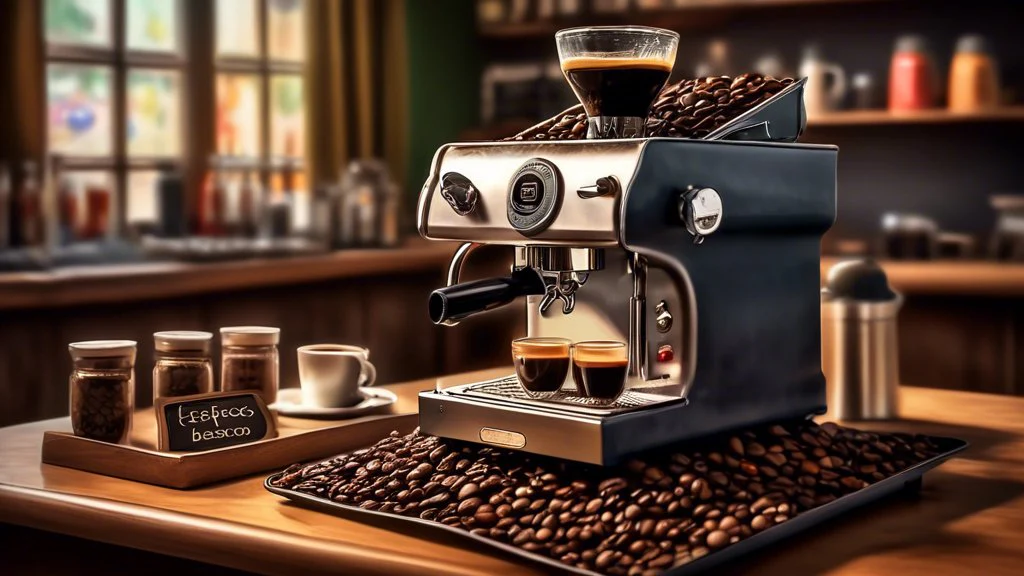Everything You Need to Know
In the world of coffee enthusiasts, there’s a growing demand for the convenience and quality that a home espresso machine brings. Whether you’re an amateur barista or just someone who enjoys a great cup of espresso, having a high-quality espresso machine in your kitchen can elevate your coffee game. But with so many options available in the market, it can be difficult to choose the best one. In this comprehensive guide, we will take a deep dive into everything you need to know about home espresso machines, from what they are, how they work, to how to choose the right one for your needs.
What is a Home Espresso Machine?
A home espresso machine is a specialized coffee-making device designed to brew high-pressure espresso directly in your own kitchen. Unlike traditional drip coffee makers, which make regular coffee by soaking ground beans in hot water, an espresso machine forces hot water through finely-ground coffee at a high pressure, resulting in a concentrated and flavorful shot of coffee called espresso.
Espresso is the base for a variety of coffee drinks, including lattes, cappuccinos, macchiatos, and Americanos. The home espresso machine allows coffee lovers to replicate café-quality espresso without needing to leave the house.
How Does a Home Espresso Machine Work?
The process of making espresso involves several steps, and understanding the mechanics of a home espresso machine can help you appreciate the craftsmanship behind it. Here’s a breakdown of how these machines work:
- Grinding: The process starts with freshly ground coffee beans. Espresso requires a fine grind, which allows water to extract the flavors efficiently under pressure. Many home espresso machines come with a built-in grinder, or you can use a separate coffee grinder.
- Water Heating: The machine heats water to a temperature between 190°F and 200°F (88°C – 93°C), which is the optimal range for extracting flavors from the coffee grounds.
- Brewing: Once the water is heated, it is forced through the coffee grounds at high pressure (usually around 9 bars). The pressure forces the water to extract oils, flavors, and aromas from the coffee, creating a rich, concentrated shot of espresso.
- Extraction: The final product, a shot of espresso, should have a smooth, creamy layer of “crema” on top—this is a golden-brown foam formed by the oils and air bubbles in the coffee.
Types of Home Espresso Machines
There are different types of home espresso machines, each offering unique features and varying levels of control over the brewing process. Understanding these types can help you decide which one best suits your needs.
1. Manual Espresso Machines
Manual espresso machines require the most involvement from the user. With these machines, you have full control over the espresso-making process, including how much pressure you apply to the water during extraction. These machines are perfect for coffee purists who want complete control over every aspect of their espresso brewing.
- Advantages: Full control over the brewing process.
- Disadvantages: Requires more effort and experience.
2. Semi-Automatic Espresso Machines
Semi-automatic machines are a popular choice for home users because they balance convenience with control. With these machines, the water temperature and pressure are controlled automatically, but you still need to grind the coffee, tamp it, and control the extraction time.
- Advantages: Offers a good balance of convenience and control.
- Disadvantages: Requires manual effort in grinding and tamping.
3. Fully Automatic Espresso Machines
Fully automatic machines take the semi-automatic process a step further by automating most aspects of brewing. These machines grind, tamp, brew, and even steam milk at the push of a button, making them ideal for beginners or those who want a hands-off experience.
- Advantages: Extremely easy to use; convenient for beginners.
- Disadvantages: Less control over the final product.
4. Super-Automatic Espresso Machines
Super-automatic espresso machines are the most convenient option, automating every aspect of the coffee-making process. From grinding the beans to frothing milk, these machines do everything at the push of a button. They are perfect for users who want a hassle-free experience with minimal manual effort.
- Advantages: Fully automated, extremely easy to use.
- Disadvantages: Higher price point and less customization.
5. Capsule or Pod Espresso Machines
Capsule or pod machines are the easiest option for those who want espresso without the mess and complexity of traditional espresso machines. These machines use pre-packaged coffee pods to make espresso, which eliminates the need for grinding and tamping. While they sacrifice some flavor complexity, they are incredibly convenient.
- Advantages: Fast, easy, and mess-free.
- Disadvantages: Limited flavor customization and ongoing pod cost.
Key Features to Look for in a Home Espresso Machine
Choosing the best home espresso machine depends on a variety of factors. Here are some key features to look out for:
1. Pressure System
The pressure at which water is forced through the coffee grounds is a crucial factor in making good espresso. A pressure of 9 bars is standard for most machines, but some machines offer more or less pressure. Look for machines with consistent pressure to achieve a quality espresso shot.
2. Temperature Control
Consistent water temperature is key to brewing a perfect espresso. Machines with PID (proportional-integral-derivative) controllers offer precise temperature control, ensuring that the water stays within the ideal brewing range throughout the process.
3. Built-In Grinder
While not all home espresso machines come with grinders, having one built-in can save you time and effort. Freshly ground coffee is crucial to making great espresso, so having an integrated grinder ensures you can brew espresso with the freshest coffee possible.
4. Steam Wand for Frothing Milk
If you enjoy milk-based drinks like lattes or cappuccinos, a steam wand is essential. Look for a machine with a high-quality steam wand that allows you to froth milk to your preferred texture and temperature.
5. Ease of Cleaning and Maintenance
Regular cleaning is crucial for maintaining the performance of your home espresso machine. Look for machines with removable parts that are dishwasher safe or easy to clean manually. Machines with built-in cleaning cycles can also simplify maintenance.
6. Size and Design
Espresso machines come in a variety of sizes and designs, so consider the space available in your kitchen. While large machines can make great espresso, they might not fit in smaller kitchens. Choose a machine that balances performance with the space you have.
How to Use a Home Espresso Machine
Using a home espresso machine can vary slightly depending on the model, but the basic steps are generally the same:
- Grind your Coffee: Freshly grind your coffee beans to a fine consistency for espresso. The grind size should be like powdered sugar.
- Preheat the Machine: Turn on the machine and allow it to reach the optimal brewing temperature.
- Tamp the Grounds: After placing the ground coffee into the portafilter, use a tamper to apply even pressure to the grounds. A proper tamp ensures even extraction.
- Brew the Espresso: Lock the portafilter into the machine and start the brewing process. The water should flow evenly through the coffee grounds, creating a rich shot of espresso.
- Serve and Enjoy: Once the espresso is brewed, serve it in a pre-warmed cup and enjoy. If desired, you can also steam milk for lattes or cappuccinos.
Benefits of Owning a Home Espresso Machine
- Convenience: With a home espresso machine, you can enjoy fresh, café-quality espresso without leaving your home.
- Cost-Effective: While the initial investment may be high, owning an espresso machine saves you money in the long run by reducing the cost of daily coffee shop visits.
- Customization: You have full control over the strength, flavor, and texture of your espresso, allowing you to personalize each cup.
- Variety: A home espresso machine opens up the possibility of making a variety of coffee drinks, from basic espresso to complex lattes and cappuccinos.
Final Thoughts
Investing in a home espresso machine is a game-changer for any coffee lover. With so many options available, it’s important to choose a machine that fits your lifestyle and preferences. Whether you prefer a manual machine for full control or a super-automatic one for convenience, there’s a home espresso machine out there for you.
By understanding the types of machines, key features, and how to use them, you’ll be able to make informed decisions when purchasing your espresso machine. Ultimately, a home espresso machine offers the convenience, quality, and customization that makes each cup of coffee a special experience.



































